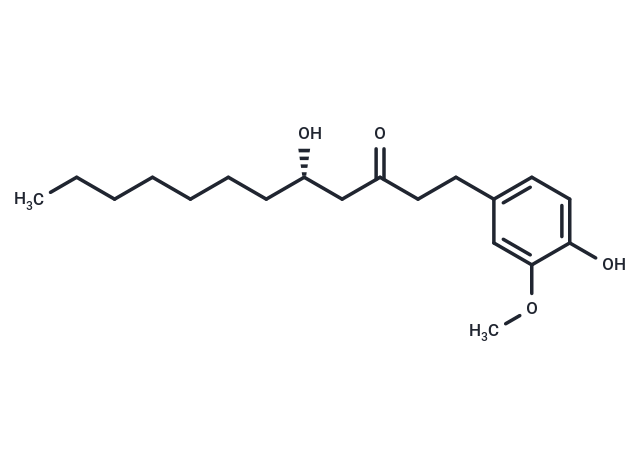- Remove All
 Your shopping cart is currently empty
Your shopping cart is currently empty
8-Gingerol
1. 8-Gingerol has antioxidant activity. 2. 8-Gingerol has antimycobacterial activity. 3. 8-Gingerol could be used as an effective skin-whitening agent. 4. 8-Gingerol shows antipyretic and anti-inflammation characteristics. 5. 8-Gingerol seems to be effective in an animal model of rheumatoid arthritis. 6. 8-Gingerol inhibits the anti-serotonin 3 receptor function, exhibits cardiotonic activity. 7. 8-Gingerol affects gastric motility and potentially have an antispasmodic effect on the gastrointestinal system. 8. 8-gingerol inhibited melanogenesis in B16F1 and B16F1 cells by down-regulation of both mitogen-activated protein kinases (MAPK) and protein kinase A (PKA) signaling pathways or through its antioxidant properties.

8-Gingerol
| Pack Size | Price | Availability | Quantity |
|---|---|---|---|
| 1 mg | $48 | In Stock | |
| 5 mg | $98 | In Stock | |
| 10 mg | $182 | In Stock | |
| 25 mg | $295 | In Stock | |
| 50 mg | $495 | In Stock | |
| 100 mg | $748 | In Stock | |
| 500 mg | $1,520 | In Stock | |
| 1 mL x 10 mM (in DMSO) | $88 | In Stock |
Product Introduction
| Description | 1. 8-Gingerol has antioxidant activity. 2. 8-Gingerol has antimycobacterial activity. 3. 8-Gingerol could be used as an effective skin-whitening agent. 4. 8-Gingerol shows antipyretic and anti-inflammation characteristics. 5. 8-Gingerol seems to be effect |
| Molecular Weight | 322.44 |
| Formula | C19H30O4 |
| Cas No. | 23513-08-8 |
| Smiles | CCCCCCC[C@H](O)CC(=O)CCc1ccc(O)c(OC)c1 |
| Relative Density. | 1.058 g/cm3 |
| Storage | Powder: -20°C for 3 years | In solvent: -80°C for 1 year | Shipping with blue ice. | |||||||||||||||||||||||||||||||||||
| Solubility Information | DMSO: 70 mg/mL (217.09 mM), Sonication is recommended. Chloroform, Dichloromethane, Ethyl Acetate, Acetone, etc.: Soluble | |||||||||||||||||||||||||||||||||||
Solution Preparation Table | ||||||||||||||||||||||||||||||||||||
DMSO
| ||||||||||||||||||||||||||||||||||||
Sci Citations
Calculator
In Vivo Formulation Calculator (Clear solution)
Dose Conversion
Tech Support
Keywords

Copyright © 2015-2025 TargetMol Chemicals Inc. All Rights Reserved.



